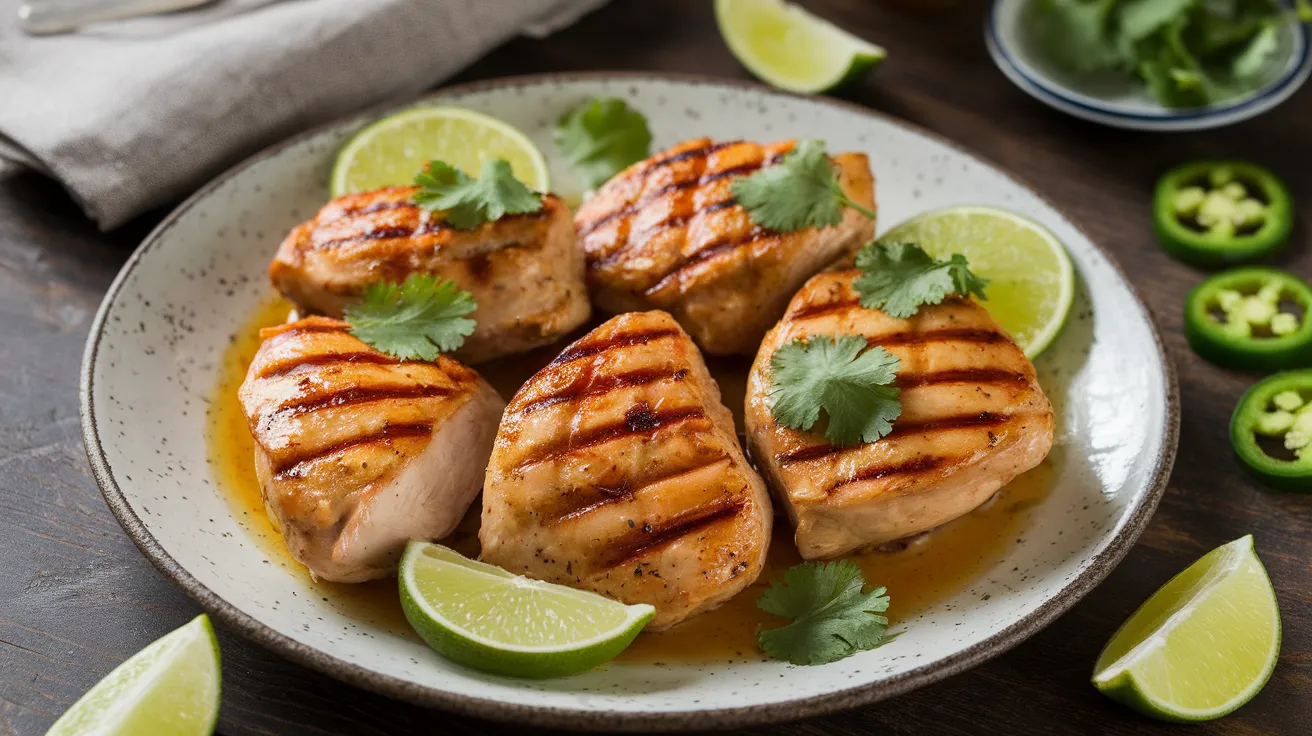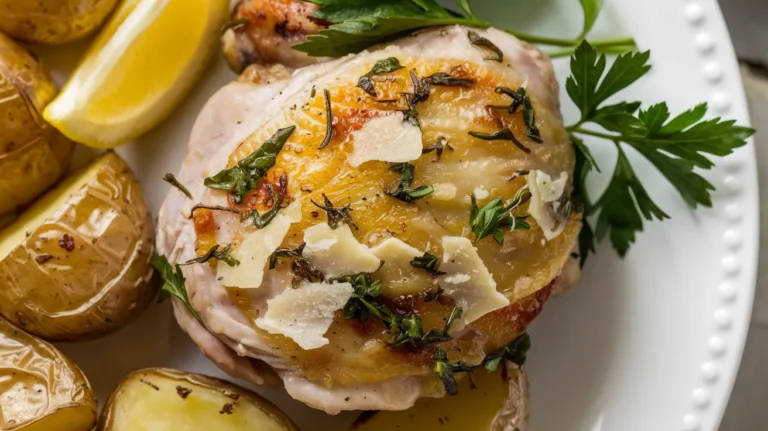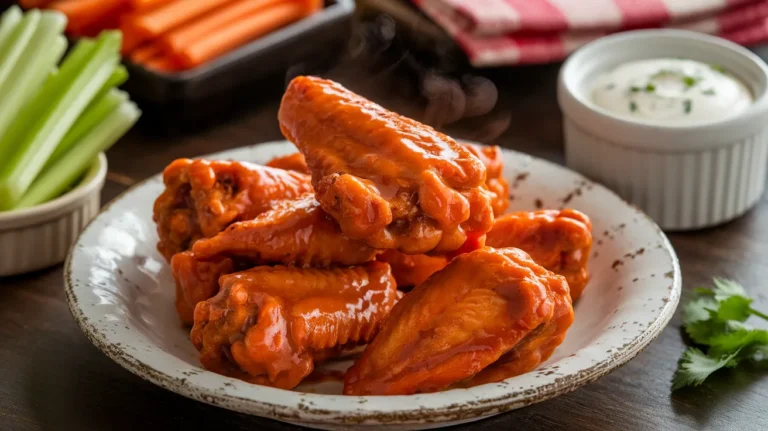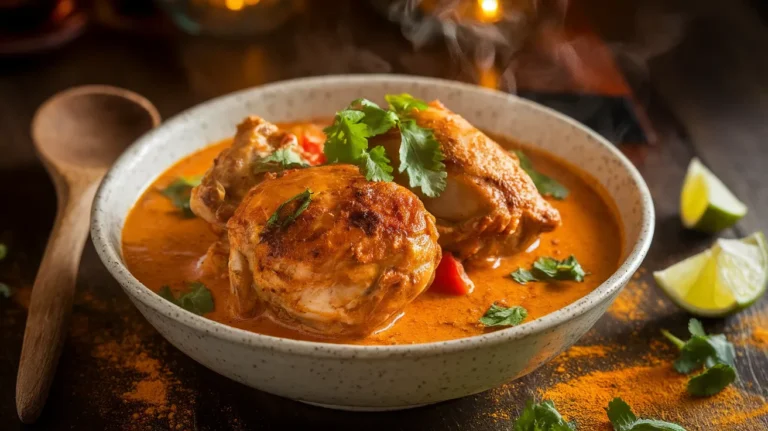This tequila lime chicken delivers restaurant-quality flavor with a zingy marinade that transforms ordinary chicken breasts into juicy, citrus-kissed perfection. The tequila lime chicken recipe combines bright lime juice, smooth tequila, and aromatic garlic for a Mexican-inspired dish that’s surprisingly easy to master at home.
SERVES: 4 | PREP: 15 MIN | COOK: 25 MIN | TOTAL: 40 MIN (plus 2-4 hours marinating)
Ingredients
For the Marinade
| Ingredient | Measurement |
|---|---|
| Tequila (silver/blanco) | ¼ cup |
| Fresh lime juice | ⅓ cup (about 3-4 limes) |
| Lime zest | 1 tablespoon |
| Olive oil | 3 tablespoons |
| Garlic cloves, minced | 4 large |
| Honey | 2 tablespoons |
| Ground cumin | 1½ teaspoons |
| Chili powder | 1 teaspoon |
| Smoked paprika | ½ teaspoon |
| Salt | 1 teaspoon |
| Black pepper | ½ teaspoon |
| Fresh cilantro, chopped | ¼ cup |
For the Chicken
| Ingredient | Measurement |
|---|---|
| Boneless, skinless chicken breasts | 4 pieces (6-7 oz each) |
| Olive oil for cooking | 1 tablespoon |
For Serving (Optional)
- Fresh lime wedges
- Chopped cilantro
- Sliced jalapeños
Step-by-Step Instructions
Phase 1: Preparing the Chicken (5 minutes)
Step 1: Place each chicken breast on a cutting board and look for any uneven thick spots. The goal is uniform thickness so everything cooks evenly. If one side is noticeably thicker, you’ll need to flatten it.
Step 2: Cover the chicken with plastic wrap or place inside a gallon-sized ziplock bag. Use a meat mallet or the bottom of a heavy skillet to gently pound the thicker parts until the breast is about ¾-inch thick throughout. Why this matters: Even thickness means no raw centers or dried-out edges.
Step 3: Pat the chicken completely dry with paper towels. This step removes excess moisture that would dilute your marinade. You want those flavors to stick and penetrate the meat, not slide off.
Phase 2: Making the Marinade (5 minutes)
Step 4: Grab a medium mixing bowl and pour in your tequila. Pro tip: Use silver or blanco tequila, not aged varieties. The clear tequila has a cleaner, more agave-forward flavor that won’t compete with the lime.
Step 5: Zest your limes directly over the bowl using a microplane or fine grater. Stop when you see white pith appearing—that’s bitter and you don’t want it. You should have about 1 tablespoon of bright green zest.
Step 6: Cut those zested limes in half and juice them into the bowl. Roll them on the counter with your palm first to break up the membranes inside. You’ll get way more juice this way. Strain out any seeds.
Step 7: Add the olive oil, minced garlic, honey, cumin, chili powder, smoked paprika, salt, and black pepper to the bowl. Whisk everything together for 30 seconds until the honey dissolves completely and the marinade looks uniform. The oil might want to separate—that’s normal, just whisk again before using.
Step 8: Stir in the chopped cilantro. The herbs will infuse their flavor during marinating, and the stems actually pack more punch than the leaves, so don’t worry about removing them.
Phase 3: Marinating (2-4 hours)
Step 9: Place your chicken breasts in a large ziplock bag or a shallow glass dish. Glass or plastic only—metal bowls can react with the acidic lime juice and give your chicken a metallic taste.
Step 10: Pour the marinade over the chicken, making sure every piece is completely coated. If using a bag, squeeze out as much air as possible before sealing. This ensures the marinade stays in contact with all surfaces. Flip the bag or turn the chicken pieces so they’re fully submerged.
Step 11: Refrigerate for at least 2 hours, but 4 hours is ideal. Don’t exceed 6 hours—the lime acid will start breaking down the chicken texture and make it mushy. Set a timer if you need to.
Step 12: Flip the bag or turn the chicken halfway through marinating time. This redistributes the marinade and ensures even flavor penetration.
Phase 4: Cooking the Chicken (20-25 minutes)
Step 13: Remove the chicken from the fridge 15 minutes before cooking. Cold chicken hits a hot pan and tenses up, making it tough. Room temperature chicken cooks more evenly and stays tender.
Step 14: Heat a large skillet (cast iron works beautifully here) over medium-high heat for 2-3 minutes. Add 1 tablespoon of olive oil and swirl to coat the bottom. The oil should shimmer but not smoke—if it’s smoking, reduce the heat slightly.
Step 15: Remove the chicken from the marinade, letting excess drip off. Don’t scrape off the garlic and herb bits—they’ll create a flavorful crust. Discard the remaining marinade (it’s touched raw chicken, so it can’t be reused).
Step 16: Carefully lay the chicken breasts in the hot skillet, leaving at least an inch between each piece. You should hear an immediate sizzle. If you don’t hear that sizzle, your pan isn’t hot enough. Don’t move them around—let them cook undisturbed for 6-7 minutes.
Step 17: Check the underside by lifting one edge with tongs. You’re looking for a golden-brown crust with some caramelized char marks from the marinade sugars. When you see that beautiful color, flip each piece.
Step 18: Cook the second side for another 6-8 minutes. The chicken is done when an instant-read thermometer inserted into the thickest part reads 165°F. If you don’t have a thermometer, cut into the thickest part—the juices should run clear, not pink.
Step 19: Transfer the cooked chicken to a clean plate and tent loosely with aluminum foil. Let it rest for 5 minutes. This resting time allows the juices to redistribute throughout the meat instead of spilling out onto your cutting board.
Step 20: Slice against the grain if serving sliced, or serve whole with fresh lime wedges and extra cilantro. The lime juice squeezed over the hot chicken brightens everything up one final time.
Chef’s Notes
The Tequila Factor: Don’t skip the tequila thinking you can just add more lime. The tequila lime chicken gets its signature depth from the agave notes in the spirit, which complement the citrus without tasting boozy. The alcohol cooks off during the process.
Marinade Balance: The combination of acid (lime), fat (olive oil), and alcohol (tequila) creates the perfect tenderizing environment. Each component serves a purpose in breaking down proteins while keeping the chicken moist.
Temperature Control: Medium-high heat is crucial for this tequila lime chicken recipe. Too low and you’ll steam the chicken instead of searing it. Too high and the honey and garlic in the marinade will burn before the inside cooks through.
Batch Cooking: If your skillet can’t fit all four pieces with proper spacing, cook in two batches. Crowded chicken steams instead of sears, and you’ll lose that caramelized exterior that makes this dish special.
Nutrition Information (Per Serving)
Calories: 285
Protein: 42g
Carbohydrates: 9g
Fat: 8g
Fiber: 1g
Sugar: 6g
Sodium: 680mg
Delicious Variations
Spicy Tequila Lime Chicken: Add 1-2 minced jalapeños to the marinade and increase the chili powder to 2 teaspoons. For even more heat, try our mango habanero chicken for a fruity-spicy combination.
Grilled Version: Instead of pan-searing, cook on a preheated grill over medium-high heat (400-450°F) for 5-6 minutes per side. The char marks add smoky depth that pairs beautifully with the citrus marinade.
Blackened Tequila Lime: After marinating, coat the chicken in additional Cajun seasoning before cooking. This creates an intensely spiced crust. If you love bold seasonings, check out our Cajun marinated chicken for more inspiration.
Orange Tequila Variation: Replace half the lime juice with fresh orange juice and add orange zest. This creates a sweeter, more tropical flavor profile while maintaining the tequila’s complexity.
Storage & Reheating
Refrigerator Storage: Place cooled chicken in an airtight container and refrigerate for up to 4 days. Store any leftover marinade separately if you want to drizzle it over the reheated chicken.
Freezing: Wrap individual cooked chicken breasts tightly in plastic wrap, then place in a freezer bag. Freeze for up to 3 months. Pro tip: Freeze the raw marinated chicken instead for an even easier weeknight meal. Thaw in the fridge overnight before cooking.
Reheating: The microwave dries out chicken fast, so avoid it if possible. Instead, slice the chicken and reheat in a skillet with a tablespoon of water or chicken broth over medium heat for 3-4 minutes. The liquid creates steam that keeps everything moist.
Meal Prep: This tequila lime chicken works brilliantly for meal prep. Cook all four pieces on Sunday, then slice and portion into containers with rice, beans, and vegetables for grab-and-go lunches.
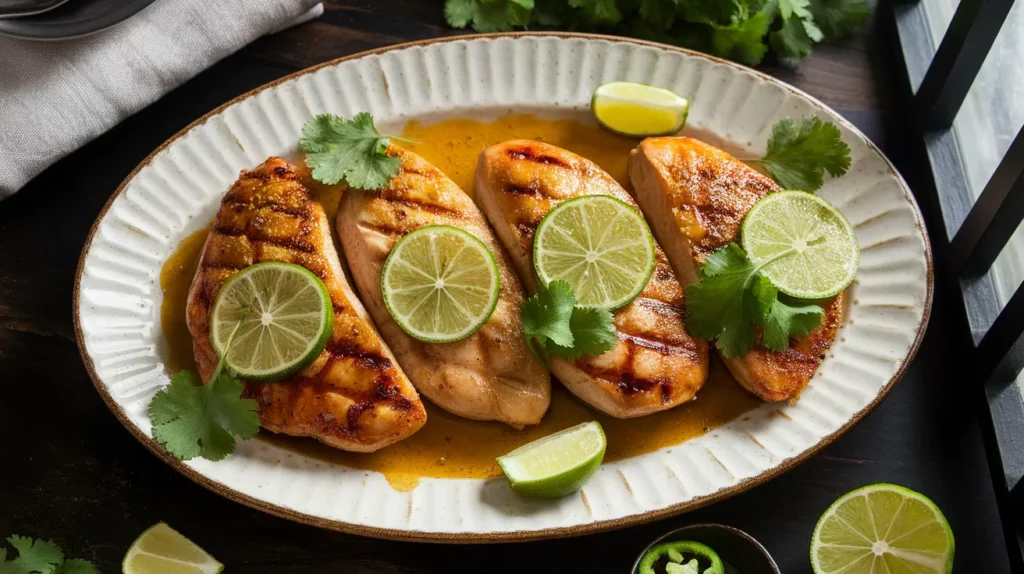
Troubleshooting Common Problems
Problem: Chicken is dry and tough
Solution: You either overcooked it or didn’t let it rest. Chicken continues cooking after you remove it from heat, so pull it off at 160°F if you’re worried about overcooking. The temperature will climb to 165°F during resting. Also, always let chicken rest 5 minutes before cutting—this is non-negotiable for juicy results.
Problem: Marinade tastes too acidic
Solution: The lime juice might be too concentrated. Next time, add an extra tablespoon of honey to balance the acidity. You can also reduce the lime juice to ¼ cup and add 2 tablespoons of orange juice for a mellower citrus flavor.
Problem: Chicken has a mushy texture
Solution: You marinated too long. The lime acid essentially “cooks” the protein if left too long. Stick to the 2-4 hour window, maximum 6 hours. If you want to prep ahead, mix the marinade separately and add it to the chicken only 3 hours before cooking.
Problem: The garlic and honey are burning in the pan
Solution: Your heat is too high, or you didn’t let enough marinade drip off before cooking. Reduce to medium heat and give the chicken a gentle shake over the bowl before placing it in the pan. A little marinade is good for crust; too much creates burning.
Problem: Chicken is sticking to the pan
Solution: Either your pan wasn’t hot enough when you added the chicken, or you tried to flip too early. Let a proper crust form—it will release naturally when ready. Also, make sure your pan is well-oiled. If using stainless steel, preheat it properly and use enough oil to create a barrier.
Equipment Essentials
- Large ziplock bag or glass dish (for marinating)
- Microplane or zester (for lime zest)
- Citrus juicer (speeds up the process)
- Meat mallet (for even thickness)
- Large skillet (cast iron or stainless steel preferred)
- Instant-read thermometer (for perfect doneness)
- Tongs (for flipping without piercing)
- Cutting board (separate one for raw chicken)
- Sharp knife (for slicing and serving)
Shopping List
Produce Section
- 4 large limes
- 1 bunch fresh cilantro
- 1 head of garlic
- Optional: jalapeños for serving
Meat Department
- 4 boneless, skinless chicken breasts (6-7 oz each)
Pantry/Baking Aisle
- Olive oil
- Honey
- Ground cumin
- Chili powder
- Smoked paprika
- Salt and black pepper
Liquor Section
- Silver/blanco tequila (small bottle is fine)
Success Secrets
1. Pound for perfection. Uniform thickness is the single most important factor in cooking chicken evenly. Take the extra 2 minutes to flatten those breasts properly.
2. Fresh lime juice only. Bottled lime juice lacks the bright, aromatic oils found in fresh limes. Those oils are what make this tequila lime chicken sing. Zest first, then juice.
3. Don’t rush the sear. When you place chicken in the hot pan, resist the urge to move it around. Let it sit untouched for those first 6-7 minutes. That’s when the crust develops.
4. Use the marinade wisely. Never reuse marinade that’s touched raw chicken. If you want a sauce, reserve a portion before adding the chicken, or make a fresh batch.
5. Temperature is your friend. Invest in an instant-read thermometer. Guessing leads to dry chicken. 165°F is the target, and you’ll hit it perfectly every time with a thermometer.
